
Product test
Hyundai Kona EV tested: The whirring grin
by Dominik Bärlocher
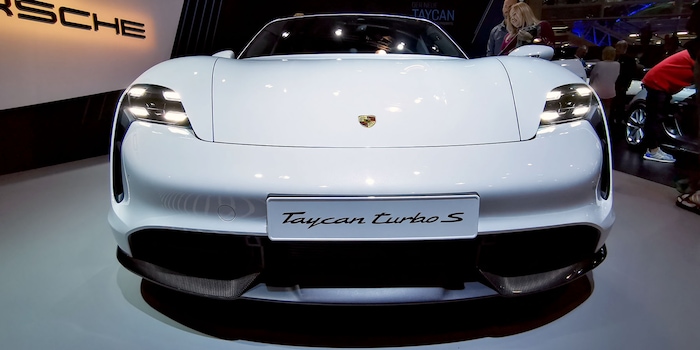
The Porsche Taycan is shown to the public. A few minutes in the Cockpit show how Porsche envisions the future of the car. And what went wrong with the steering wheel?
The Auto Zürich is not only showing new cars, classic cars and all kinds of accessories (including, for some reason, televisions from Samsung and LG) this weekend. One highlight will be on the stand of German sports car brand Porsche: the Porsche Taycan.
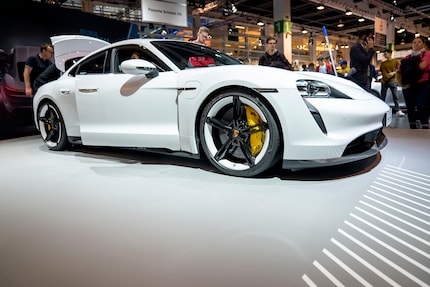
The Taycan is Porsche's answer to Tesla, the Hyundai Kona and the rest. With the Taycan, Porsche is entering the race for the future of the car. Initial praise is somewhere between impressive and strange. The first record claimed by Porsche for the Taycan is "fastest lap of a four-door electric vehicle". A record that Porsche probably invented for the Taycan at the Nürburgring. In terms of marketing, this is only slightly removed from the ultra-specific "Fastest lap of a red electric vehicle on a Tuesday afternoon". Nevertheless, the Taycan is fast and impressive. But how much of it is hype? How much truth?
At Auto Zurich, you have the opportunity to take a seat in the cockpit of the electric sports car for the first time, feel the wheel and look at the new dashboard. But you can't drive it. What a pity. But understandable.
When you sit down in the Taycan, one illusion vanishes: that the Taycan is a Porsche inside and out. On the outside, yes. Because no one will ever be able to deny that the Porsche Taycan is indeed a Porsche. The design, even with the new "sabre teeth" under the headlights, feels like the logical evolution of classic Porsche ideas. Really great work.
I'm sitting down.
I touch the steering wheel.
Oh God.
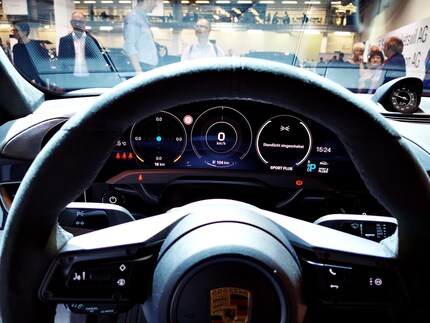
Alcantara.
A small insertion here: I, as a person, do not like Alcantara. Not at all. I don't like synthetic microfibre. Not in cars, not on Microsoft's Surface laptops. But I'm aware that I'm in the minority here. Because if I wasn't in the minority, car manufacturers and Microsoft would have stopped using Alcantara a long time ago. I shudder at the very thought of plush technology. End of the insertion.
The rest of the steering wheel is pleasantly minimalist. After all, many modern cars have an infinite number of buttons on the steering wheel. Cruise control, voice assistant, telephone control, stereo system and control pad for the onboard computer. That makes perfect sense. At least in theory. You're not supposed to fiddle with the centre console while driving, but keep your eyes on the road. There's nothing wrong with this logic in itself, but if there are a dozen buttons that feel identical, then the concept falls apart. The Taycan, however, has moved many of these controls to the tablet in the centre console. This makes the steering wheel surprisingly slim and pleasant. Beautiful.
The Porsche Taycan is an automatic. Of course it is, because I'm sure that the computer in the Taycan will shift gears better than a normal person ever could. Except for racing drivers. Maybe. But as a driver, you still have to be able to shift from D to N or R somewhere. You will look in vain for a gear stick, because the centre console has been almost completely replaced by a tablet. There also don't seem to be any buttons, as in the Hyundai Kona EV, that control the gearshift.
Well, gear sticks and gear changes in EVs are one of those things. With the exception of the Porsche Taycan, all EVs on the market only have one gear forwards and one backwards. You don't have to shift much. Porsche, however, has built a second gear into the Taycan, inspired by solutions from motorsport. Does that really make a difference in everyday driving? Can I shift manually with the new two-speed gearbox? Or are these just two driving modes?
The tablet in the centre is very reminiscent of Tesla. Everything you can do with the vehicle is centralised there. Air conditioning, opening doors, opening and closing the petrol cap and all sorts of other things. The first functions seem to be quite easy to access and use. It's a bit difficult to tell when the key that unlocks all the functions is too far away from the vehicle on the stand at the Zurich show and the car seems to be in a demo mode that prevents it from starting up. Okay, that makes sense, because otherwise I would be the first to think about driving a metre forwards and backwards.
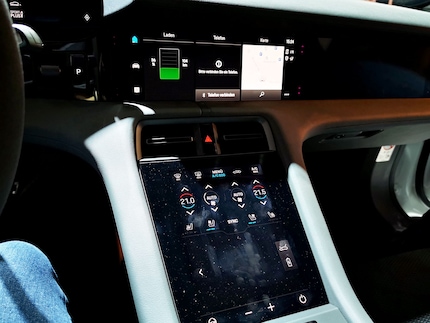
The smaller display just above the main tablet, which is a magnet for fingerprints, is more worrying. This is because it shows information about the vehicle. And the navigation system? If the display is not configurable and the display remains in thirds and the navigation is still supplied there, then you may be better off with a larger, external sat nav.
But it's really too early to criticise anything here.
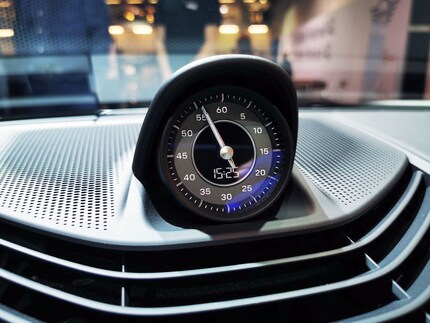
An absolute highlight, however, is the clock on the dashboard. The second hand is old-fashioned and ticks once a minute in a circle. Somehow the hand makes a nice classic contrast amidst all the futuristic displays.
One small detail, however, particularly amused me during the short time I had with the Taycan in Zurich's Hallenstadion. The petrol cap. EVs like the Kona or JAC have a lever inside that you can use to release the power sockets. You press the button and a lid pops open quite abruptly and clumsily. With the Taycan, however, Porsche has thought of something.
You either press a button on the tablet or swipe the black decorative element on the outside next to the fuel filler cap. The lid then opens slowly and in a controlled manner.
Is that useless? Yes. Is it completely over-engineered? Of course it is. But it looks good and is fun. The fact that the Porsche Taycan has two petrol caps is also exciting. Both are right in front of the passenger compartment. A CCS Charger is hidden on the passenger side and a Type 2 Charger on the driver's side. Strange. Exciting. What happens when both are connected? Does the Taycan charge faster?
There's only one way to find out. On the road. Behind the wheel.
If you want to take a seat in the Porsche Taycan yourself, Auto Zürich is still open until and including Sunday, 3 November 2019.
Journalist. Author. Hacker. A storyteller searching for boundaries, secrets and taboos – putting the world to paper. Not because I can but because I can’t not.
Interesting facts about products, behind-the-scenes looks at manufacturers and deep-dives on interesting people.
Show all
Background information
by Anne Fischer

Background information
by Domagoj Belancic

Background information
by Dominik Bärlocher